
Phytophthora is a genus of plant-damaging oomycetes, whose member species are capable of causing enormous economic losses on crops worldwide, as well as environmental damage in natural ecosystems. The cell wall of Phytophthora is made up of cellulose. The genus was first described by Heinrich Anton de Bary in 1875. Approximately 210 species have been described, although 100–500 undiscovered Phytophthora species are estimated to exist.

Acacia baileyana or Cootamundra wattle is a shrub or tree in the flowering plant family Fabaceae. The scientific name of the species honours the botanist Frederick Manson Bailey. It is indigenous to a very small area in southern inland New South Wales, comprising Temora, Cootamundra, Stockinbingal and Bethungra districts. However, it has been widely planted in other Australian states and territories. In many areas of Victoria, it has become naturalised and is regarded as a weed, outcompeting indigenous Victorian species.

Acacia cultriformis, known as the knife-leaf wattle, dogtooth wattle, half-moon wattle or golden-glow wattle, is a perennial tree or shrub of the genus Acacia native to Australia. It is widely cultivated, and has been found to have naturalised in Asia, Africa, North America, New Zealand and South America. A. cultriformis grows to a height of about 4 m (13 ft) and has triangle-shaped phyllodes. The yellow flowers appear from August to November in its natural range. Its attractive foliage and bright flowers make it a popular garden plant.
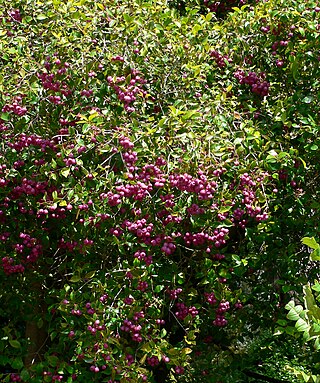
Syzygium smithii is a summer-flowering, winter-fruiting evergreen tree, native to Australia and belonging to the myrtle family Myrtaceae. It shares the common name "lilly pilly" with several other plants.It is planted as shrubs or hedgerows, and features: rough, woody bark; cream and green smooth, waxy leaves; flushes of pink new growth; and white to maroon edible berries. Unpruned, it will grow about 3–5 m (9.8–16.4 ft) tall in the garden.

The Proteaceae form a family of flowering plants predominantly distributed in the Southern Hemisphere. The family comprises 83 genera with about 1,660 known species. Australia and South Africa have the greatest concentrations of diversity. Together with the Platanaceae, Nelumbonaceae and in the recent APG IV system the Sabiaceae, they make up the order Proteales. Well-known 'Proteaceae genera include Protea, Banksia, Embothrium, Grevillea, Hakea and Macadamia. Species such as the New South Wales waratah, king protea, and various species of Banksia, Grevillea, and Leucadendron are popular cut flowers. The nuts of Macadamia integrifolia are widely grown commercially and consumed, as are those of Gevuina avellana on a smaller scale.

Grevillea aquifolium is a shrubby or scrambling plant endemic to South Australia and Victoria. Common names include holly grevillea, prickly grevillea or variable prickly grevillea. It occurs naturally in woodland, open forest and heathland.
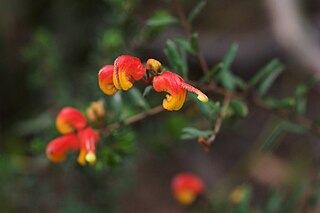
The Australian flowering shrub Grevillea alpina has several common names, including mountain grevillea, alpine grevillea, and cat's claws. It is not limited to alpine environments, and in fact is less common at high elevation than low. The species is variable in appearance, with five general forms described: small-flowered, Grampians, Northern Victorian, Goldfields, and Southern Hills forms. It is found in dry forests and woodlands across Victoria and into southern New South Wales. Some forms of the plant are low to the ground, and some become a spreading shrub. The flowers come in many colours, from white to green to shades of red and pink, or a pattern of several colours. The curled flowers are 1 to 3 centimetres in length. It is attractive to nectar-feeding insects and birds.

Grevillea 'Superb' is a widely grown grevillea cultivar bred by Merv Hodge in Queensland. It is a hybrid of a white-flowered Grevillea banksii, from Queensland, and the Western Australian plant G. bipinnatifida.
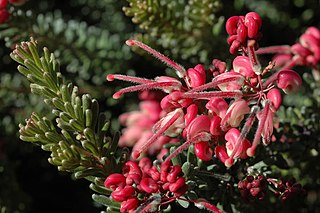
Grevillea lanigera, commonly known as woolly grevillea, is a species of flowering plant in the family Proteaceae and is endemic to south-eastern continental Australia. It is a spreading shrub with narrowly oblong to more or less linear leaves and clusters of pink to red, and cream-coloured flowers.

Grevillea humifusa, commonly known as spreading grevillea, is a species of flowering plant in the family Proteaceae and is endemic to a restricted area of the south-west of Western Australia. It is a prostrate shrub with long, trailing stems, divided lives with linear lobes and clusters of pink to pale red and cream-coloured flowers with a reddish, yellow-tipped style.
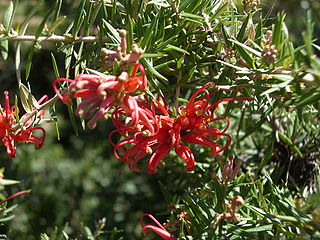
Grevillea juniperina, commonly known as juniper- or juniper-leaf grevillea or prickly spider-flower, is a plant of the family Proteaceae native to eastern New South Wales and southeastern Queensland in Australia. Scottish botanist Robert Brown described the species in 1810, and seven subspecies are recognised. One subspecies, G. j. juniperina, is restricted to Western Sydney and environs and is threatened by loss of habitat and housing development.
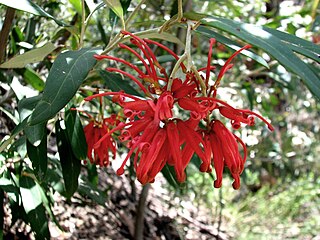
Grevillea victoriae, also known as royal grevillea or mountain grevillea, is a species of flowering plant in the family Proteaceae and is endemic to mountainous regions of south-eastern continental Australia. It is an erect to spreading shrub with elliptic to lance-shaped leaves, and pendulous clusters of red to orange flowers.
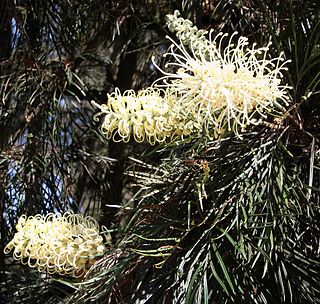
Grevillea 'Moonlight' is a widely cultivated and popular garden plant in Australian gardens and amenities.+

Coprosma repens is a species of flowering shrub or small tree of the genus Coprosma, in the family Rubiaceae, native to New Zealand. Common names include taupata, tree bedstraw, mirror bush, looking-glass bush, New Zealand laurel and shiny leaf.

Grevillea pteridifolia is a species of flowering plant in the family Proteaceae and is endemic to northern Australia. It is also known by many common names, including golden grevillea, silky grevillea, fern-leaved grevillea, golden parrot tree, golden tree, manbulu, yawuny and tjummula. It is a shrub or tree usually with pinnatisect leaves, and bright orange-yellow or reddish flowers.
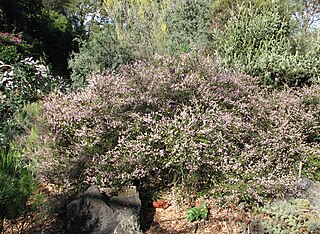
Thryptomene 'F.C. Payne', commonly known as Payne's thryptomene, is an Australian native plant cultivar that is widely grown in Australia. It is a selected form of Thryptomene saxicola, a species from Western Australia.
William Lancashire Cane (1911–1987) was an Australian plantsman who introduced many new native plant species, forms and hybrids into cultivation.

Alternanthera dentata, known as little ruby and ruby leaf alternanthera, is a fast-growing ornamental groundcover plant in the amaranth family which was first described by Conrad Moench, and got its current name from Stuchlík and Robert Elias Fries. Native to the West Indies and Brazil, the plant is chiefly grown for its coloured foliage. It is one of the dozen synonyms of Alternanthera brasiliana, and is alike in appearance with Alternanthera bettzickiana, which all have strikingly similar looking cultivars.

Vitis 'Ornamental Grape', also known as ornamental grapevine, Ganzin glory, glory vine and crimson glory, is a nonfruiting ornamental plant that is a hybrid of Vitis vinifera and Vitis rupestris.


















